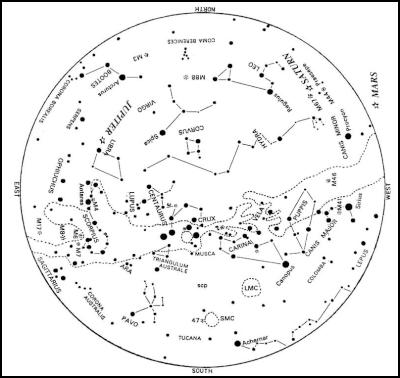The May Night Sky
THE NATIONAL OBSERVATORY OF NEW ZEALAND
THE NIGHT SKY
Brian Carter*
THE MAY NIGHT
SKY
Nights are getting colder and longer for looking at the stars and planets.
Planets
May is a good month for observing the planets. All 5 major planets, Mercury, Venus, Mars, Jupiter and Saturn, are visible, although Mercury for only the first few days of the month.
Mars will be visible for the first quarter of the night. At the start of the month it sets at 20 57 and at 20 28 by month’s end. Mars starts the month in the constellation of Gemini, moving into Cancer on May 31. Its magnitude fades from 1.5 to 1.7 during the month.
Saturn will be visible for the first third of the night. At the start of May it sets at 23 04 and at 21 16 by month’s end. Saturn is in the constellation of Cancer, in which it remains until September 2006. Its magnitude slightly fades from 0.3 to 0.4.
Jupiter will be visible for all of the night except at the very end of the night towards the end of May. By the end of the month it sets at 05 18. Jupiter is in the constellation of Libra, in which it remains until December 2006. During the month its magnitude slightly fades from –2.5, it’s brightest for the year, to –2.4.
Venus will be visible for the last quarter of the night. At the start of the month it rises at 03 26 and at 04 21 by month’s end. Venus starts the month in the constellation of Pisces, moving into Cetus on May 10, and back into Pisces on May 14. During May its brilliant magnitude slightly fades from –4.1 to –4.0.
Mercury will be visible in the morning sky just before dawn for the first few days of May. At the start of the month it rises at 05 30 and by May 9 at 06 15, an hour before Sunrise and by May 19 it rise at the same time as the Sun. It starts the month in the constellation of Pisces, moving into Aries on May 7, and finally into Taurus on May 18. Its magnitude rapidly increases from –0.5 to –1.5 by May 13.
All times are for Wellington unless otherwise stated. Other centres may vary by a few minutes.
Phases of the Moon
First Quarter – May 5 at 17:13.
Full Moon –
May 13 at 18:51.
Last Quarter – May 20 at 21:21.
New
Moon – May 27 at 17:26.
Diary of Astronomical Phenomena
May 4 Saturn 4°N of Moon at
21:00.
5 Jupiter at opposition (on the opposite side of
the Earth to the Sun) at 03:00.
7 Moon at apogee
(furthest from the Earth) at 19:00 (Distance = 0.0027044 AU
= 404,570 km).
13 Jupiter 5°N of Moon at
04:00.
13 Full Moon at 18 51.
15 Occultation of
Antares by the Moon at ~03 00 (see elsewhere in this
Newsletter).
19 Mercury in superior conjunction (on the
far side of the Sun) at 08:00.
23 Moon at perigee
(closest to the Earth) at 03:00. (Distance = 0.0024640 AU =
368,610 km).
25 Mars close to Pollux in the evening
sky
27 New Moon at 17:26.
MAY SKY CHART
This chart
shows the sky as it appears at about 21:00 for ~May
15.

Click for big version
How To Use the Sky
Charts
To use the sky chart hold it up to the sky so that
the direction in which you are looking is at the lower edge
of the map. For example, if you are looking at the western
horizon then the map should be held so that the “WEST” label
is at the lower edge. The altitude and direction of the
stars and planets will then be correctly shown. The centre
of the chart will be directly overhead.
* Brian Carter is the Senior Astronomer at Carter Observatory (The National Observatory of New Zealand), PO Box 2909, Wellington. (Observatory Web Site: www.CarterObservatory.org)


 Binoy Kampmark: Commemorating Mummy - Reflections On Mother’s Day
Binoy Kampmark: Commemorating Mummy - Reflections On Mother’s Day Gordon Campbell: On The New Pope, And The Israeli Attack On Peter Davis
Gordon Campbell: On The New Pope, And The Israeli Attack On Peter Davis Martin LeFevre - Meditations: For The Love Of Sycamores
Martin LeFevre - Meditations: For The Love Of Sycamores Ian Powell: A Timely Call For A Social Contract In Health
Ian Powell: A Timely Call For A Social Contract In Health Binoy Kampmark: Bratty Royal - Prince Harry And Bespoke Security Protection
Binoy Kampmark: Bratty Royal - Prince Harry And Bespoke Security Protection Keith Rankin: Make Deficits Great Again - Maintaining A Pragmatic Balance
Keith Rankin: Make Deficits Great Again - Maintaining A Pragmatic Balance